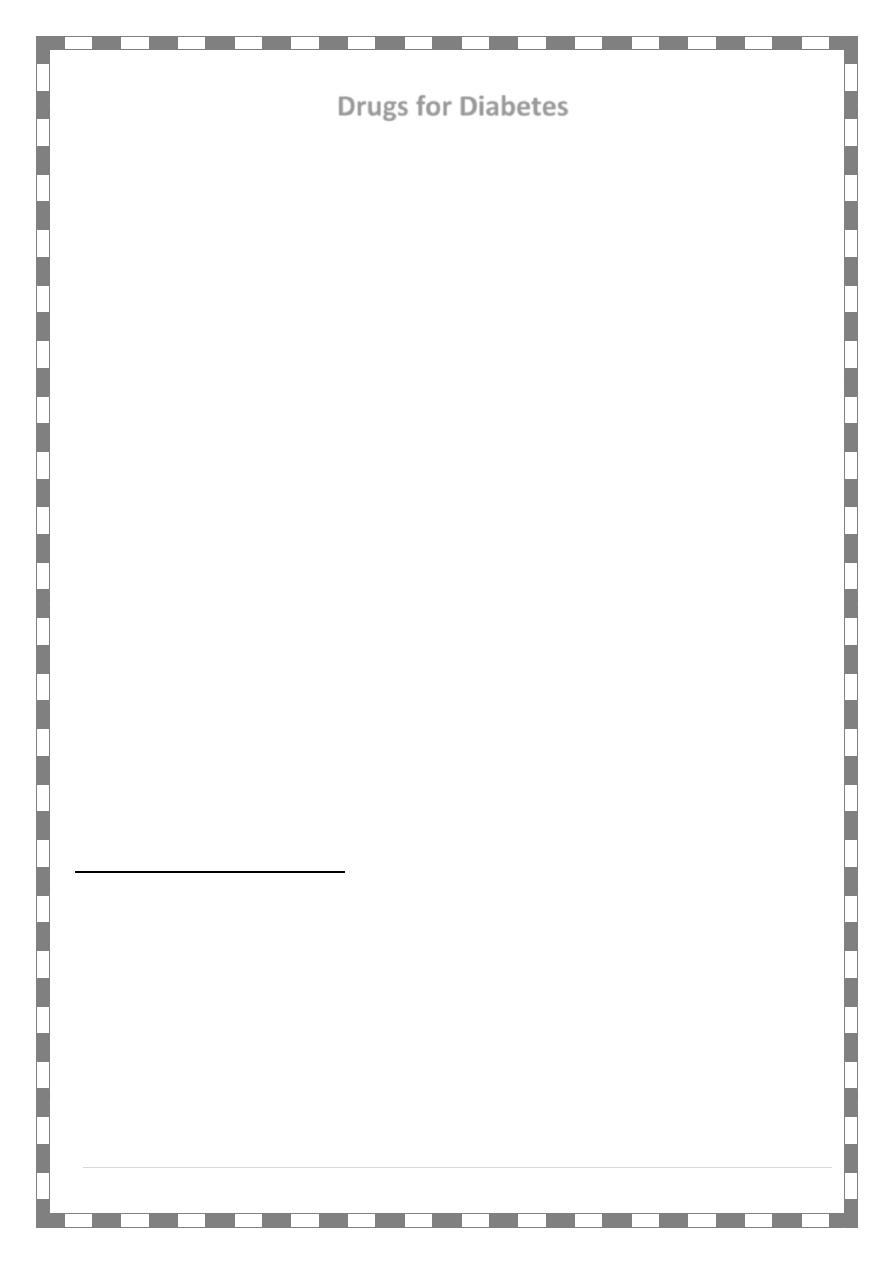
Third Stage
Pharmacology
Dr. Aqeel K.
P a g e
| 1
|
Drugs for Diabetes
Pancreas secretes peptide hormones:
Insulin B cells
Glucagon
Cells
Somatostatin Delta Cells
As you know these hormones play an important role in regulation of metabolic activities
of the body, especially glucose homeostasis.
Lack of insulin weather absolute or relative cause hyperglycemia, that's what happen in
DM.
If hyperglycemia left untreated it will lead to serious complications, either microvascular
complication (Retinopathy, Nephropathy, Neuropathy and Cardiomyopathy) or
Macrovascular complication (Ischemic heart disease, CVA, or peripheral vascular
diseases of the limbs).
As you know there are different types of DM:
1- Type 1 DM
2- Type 2 DM
3- Gestational DM
Insulin and insulin analogs
Insulin: is a polypeptide hormone consisting of two peptide chain that are connected by
disulfide bonds.
The precursor is proinsulin that undergoes proteolytic cleavage to form insulin and C-
peptide, both are secreted by B cells.
Insulin secretion is regulated by
Blood glucose level.
Certain amino acids
Other hormones
And autonomic mediators.
Exogenous insulin is administered to replace absence insulin secretion in type 1 DM or
to supplement insufficient insulin secretion in type 2 DM.
Human insulin is produced by recombinant DNA technology. Using strains of Escherichia
coli or yeast that are genetically altered to contain the gene for human insulin.

Third Stage
Pharmacology
Dr. Aqeel K.
P a g e
| 2
|
Because insulin is a polypeptide, it is degraded in the gastrointestinal tract if taken
orally.
Therefore, it is generally administered by S.C injection, or for soluble insulin can be
given I.V or I.M in emergency.
Also insulin can be given as continuous S.C insulin infusion (called insulin pump).
Adverse reaction to insulin:
1- Hypoglycemia
2- Weight gain
3- Local injection site reaction
4- Lipodystrophy
Insulin preparation
Insulin preparations are classified as:
a- Rapid
b- Short active
c- Late mediate
d- Long acting
A- Rabid
Insulin lispro
Insulin aspart
Insulin glulisine
B- Short acting
Soluble
Crystalline zin insulin
Rapid: Peak level 30-90 min
Short: 50-120 mins
The modification of the amino acid sequence of regular insulin produce analogs that are
rapid acting insulin.
Both rapid and short acting insulin are given to mimic the prandial (medtime) release of
insulin, and to control Post-prandial glucose.
Regular insulin should be injected 30min before meal.
Rapid acting 15min before meal or 15-20 min after starting a meal.

Third Stage
Pharmacology
Dr. Aqeel K.
P a g e
| 3
|
Both can be used S.C, I.M, I.V or via pump.
C-Intermediate acting insulin
Neutral Protamine Hagedorn (NPH) insulin
It formed by the addition of zinc and protamine to regular insulin.
The combination with protamine forms a complex that is less soluble resulting in
delayed absorption and longer duration of action.
NPH is used for basal (fasting) control in type 1 or type 2 DM.
It is usually given along with rapid or short acting insulin for meal time control.
NPH should be given only S.C. (Never IV)
D-Long acting insulin preparation
Insulin glargine: - it precipitates at the injection site that release insulin over an
extended period. It has a slower onset than NPH insulin and flat prolonged
hypoglycemic effect without peak.
Insulin detemir: - has a fatty acid side chain, that enhances association to
albumin. Slow dissociation from albumin result in long acting properties similar to
those of insulin glargine.
Both are used for basal controlling, given S.C.
Neither should be mixed in the same syringe with other insulin.
Synthetic Amylin Analog
Amylin is a hormone that is secreted with insulin from B cells following food intake.
Its function:
1- Delays gastric emptying
2- ↓ post-prandial glucagon secretion
3- Improve satiety.
The pramlintide is a synthetic amylin analog.
It is used as an adjunct to meal time insulin therapy in patient with type 1 DM and type
2 DM. it is given S.C. immediately prior to meals.
When we use pramlintide we should decrease the dose of insulin by 50% to avoid
hypoglycemia.
Others S.E (nausea, anorexia, vomiting)

Third Stage
Pharmacology
Dr. Aqeel K.
P a g e
| 4
|
Incretin Mimetics
Oral glucose results in a higher secretion of insulin than occurs when an equal load of
glucose is given IV (This effect is referred to as the incretin effect)
This effect occurs because the gut releases incretin hormones namely (Glucagon like
peptide-1 (G-LP-1)) and glucose dependent insulinotropic polypeptide, in response to
normal meal.
Incretin hormones are responsible for 60% to 70% of post-prandial insulin secretion.
Exenatide and liraglutide are injectable incretin mimetic useful for Rx of type 2 DM.
Mechanism of action
1- GLP-1
improve glucose dependent insulin secretion
2- Slow gastric emptying time
3- Reduce food intake by enhancing satiety
4- ↓ post-prandial glucagon secretion
5- Promote B-cell proliferation.
Leading to:
No weight gain
No post-prandial hyperglycemia
↓ HbA1c
Pharmacokinetics and fate:
The exenatide and liraglutide are polypeptide so must be given S.C.
Liraglutide has long half-life so is given once daily without regard to meal.
Exenatide is given twice daily
Now once a weak dose and 2 weeks' dose also available.
Exenatide should be avoided in patients with sever renal impairment.
Adverse effects:
Nausea
Vomiting
Diarrhea
Constipation
Rarely pancreatitis.
To be continued,,,
